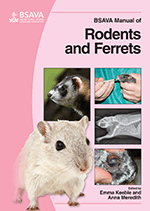
Full text loading...

Neurological and musculoskeletal disorders in rodents are characterized by clinical case reports from exotic pet practice in addition to aetiologies more commonly documented under laboratory conditions. This makes it difficult to determine the actual incidence of many neurological and musculoskeletal disorders that may present in practice and whether this has changed over time. The causes of neurological and musculoskeletal disorders can be traumatic, infectious, neoplastic, nutritional, metabolic, toxic, degenerative, idiopathic, iatrogenic, genetic or congenital, or a combination of these. Neurological and musculoskeletal diseases can be species specific or affect multiple species, be geographically restricted or generalized, and be part of a multisystemic disorder or have pathology isolated exclusively to these organ systems. Disease can very frequently have a husbandry component. This chapter explains History, physical examination and diagnostic procedures; Selected neurological and musculoskeletal conditions such as disorders associated with convulsions/seizures.
Rodents: neurological and musculoskeletal disorders, Page 1 of 1
< Previous page | Next page > /docserver/preview/fulltext/10.22233/9781905319565/9781905319565.14-1.gif

Full text loading...




